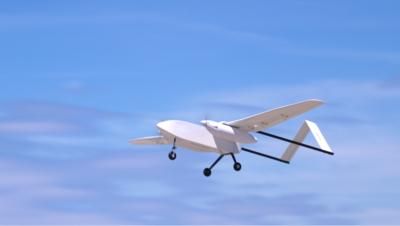Fri, Nov 25, 2022
Self-Contained Hydrogen Engine Nacelle May Be Offered as UAV Aftermarket Modification
H3 Dynamics' twin-engine hydrogen UAV demonstrator completed its first successful test flight over a Paris airfield.

The flight was a capstone of sorts, for a program that first completed a working propulsion nacelle prototype a year prior. By July, H3 Dynamics had been able to test their first distributed pod system on a scale aircraft at the Hub Drones - Systematic airfield near Paris, France. That proved the basic functionality of their hydrogen-powered system, allowing them to begin scaling up their designs. The most recent test evaluated the performance of a twin-engine, hydrogen powered, propeller-driven propulsion aircraft on the way towards larger, more complex installations. While H3 Dynamics will need to continue their progress flying small, uncrewed aircraft, the company eagerly looks to the future, with plans for bigger and better hydrogen aircraft converted from existing makes and models. With the successful demonstration of a twin-engine platform, the company says it will soon tackle a 6-engine aircraft in the same vein.
The uncrewed twin-engine test aircraft boasts a 900 km range on liquid hydrogen, stored entirely in its wing-mounted nacelles. That external mounting allows for safer, less anxiety-inducing carriage of super-flammable hydrogen fuel in addition to maximizing interior cargo storage. Should the demonstrator be powered with pressurized hydrogen, its range drops to 350 km, still quite passable given the aircraft's 30-liter interior volume. H3 Dynamics sees their standalone hydrogen nacelle design as a perfect candidate for aftermarket installation and retrofitment, an easy way to bolster the power of any small aircraft with sustainable, on-demand thrust. The compact size should mean the self-contained hydrogen nacelles can quickly be developed into a snap-on addition to existing eVTOL or fixed wing cargo drones.
“Not only is safety our first priority, but we don’t want hydrogen competing for revenue-generating air freight and passenger space,” said Taras Wankewycz, CEO of H3 Dynamics. As outlined by the company's hydrogen developers, distribution of hydrogen power is key. Spreading the hydrogen propulsion systems allows for more efficient thermal management, increased redundancy, and simpler installation.
H3 Dynamics made mention of their plan to complete an Atlantic crossing on hydrogen-electric hybrid propulsion in the next 2 years, proving the feasibility of liquid h2 power with partner ISAE-SUPAERO.
More News
He Attempted To Restart The Engine Three Times. On The Third Restart Attempt, He Noticed That Flames Were Coming Out From The Right Wing Near The Fuel Cap Analysis: The pilot repor>[...]
Make Sure You NEVER Miss A New Story From Aero-News Network Do you ever feel like you never see posts from a certain person or page on Facebook or Instagram? Here’s how you c>[...]
From 2009 (YouTube Edition): Leading Air Show Performers Give Their Best Advice for Newcomers On December 6th through December 9th, the Paris Las Vegas Hotel hosted over 1,500 air >[...]
Aero Linx: NASA ASRS ASRS captures confidential reports, analyzes the resulting aviation safety data, and disseminates vital information to the aviation community. The ASRS is an i>[...]
“For our inaugural Pylon Racing Seminar in Roswell, we were thrilled to certify 60 pilots across our six closed-course pylon race classes. Not only did this year’s PRS >[...]
 NTSB Final Report: Rutan Long-EZ
NTSB Final Report: Rutan Long-EZ ANN FAQ: Turn On Post Notifications
ANN FAQ: Turn On Post Notifications Classic Aero-TV: ICAS Perspectives - Advice for New Air Show Performers
Classic Aero-TV: ICAS Perspectives - Advice for New Air Show Performers ANN's Daily Aero-Linx (06.28.25)
ANN's Daily Aero-Linx (06.28.25) Aero-News: Quote of the Day (06.28.25)
Aero-News: Quote of the Day (06.28.25)



